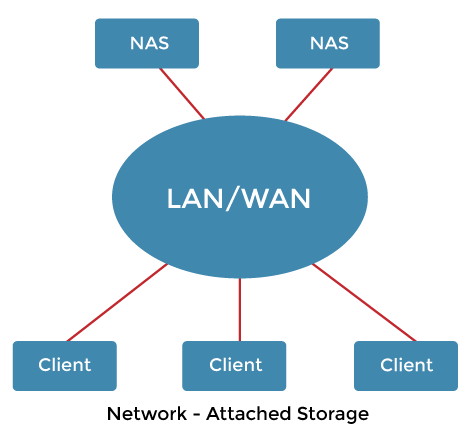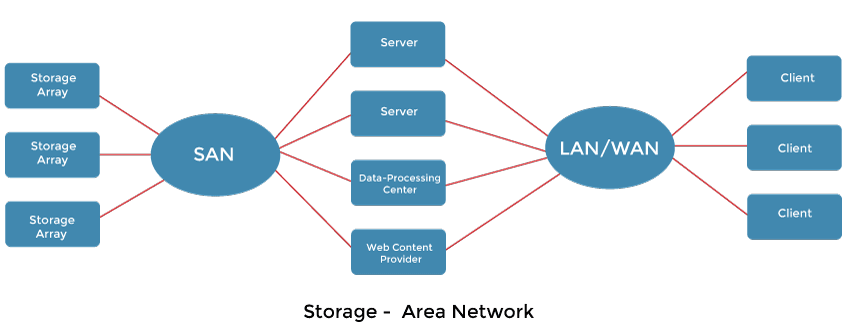Disk Attachment in Operating System
In this article, you will learn the disk attachment in the operating system with its methods.
Disk Attachment
There are two ways for computers to access disc storage. One method is to use I/O ports, also known as host-attached storage, on small systems. Another method is through a remote host in a distributed file system, which is known as network-attached storage.
Host-Attached Storage
Host-attached storage (HAS) is storage accessed via local I/O ports. These ports make use of various technologies. IDE or ATA is the I/O bus architecture used by most desktop PCs. This architecture allows for up to two drivers per I/O bus. SATA is a new related standard that has simplified cabling. High-end workstations and servers typically use more advanced I/O architectures such as Small Computer System Interface (SCSI) and fibre channel (FC).
SCSI (Small Computer System Interface) is bus architecture. Its physical medium is typically a ribbon wire with many conductors. A maximum of 16 devices may be attached to the bus using the SCSI protocol. The devices typically comprise of one controller card (SCSI initiator) on the host and up to 15 storage devices (SCSI targets). A SCSI disk is a typical SCSI target. Although, the protocol permits every SCSI target to address up to 8 logical units. Logical unit addressing is widely used to direct commands to the RATD array or portable media library components.
A Fibre Channel is a high-speed serial architecture that may use optical fibre or a four-conductor copper wire. It comes in two varieties. One type of fabric is a big switched fabric with a 24-bit address space. This variant is projected to take the lead in the future and will serve as the foundation for storage-area networks (SANs). Many hosts and storage devices may be connected to the fibre due to the large address space and switched nature of the communication that provides better flexibility in I/O communication. Another PC version is an arbitrated loop (FC-AL), which may address up to 126 devices, including drives and controllers.
As host-attached storage, a wide range of storage devices are suitable. Hard disc devices, RAID arrays, CDs, DVDs, and tape drives are among them. The I/O commands that start data transfer to a host-attached storage device can read and write logical data blocks routed to specially designated storage units.
Network-Attached Storage
A network-attached storage (NAS) device is a dedicated storage system that can be accessed via the data network. Clients access NAS through a remote procedure call interface, like a CIFS for Windows computers or a network file system for Unix. Remote procedure calls (RPCs) are transmitted through TCP or UDP via an IP network, which is often the same LAN that delivers all data traffic to the clients. Generally, the network-attached storage unit is constructed as a RAID array with software that supports the RPC interface. It is easy to consider NAS as just another storage-access protocol. For example, a NAS system may access storage through RPC via TCP/IP rather than a SCSI device driver and SCSI protocols.

NAS allows all systems on a local area network to share a pool of storage with the same simplicity of naming and access as local host-attached storage provides. However, it is less efficient and performs worse than other direct-attached storage solutions.
ISCSI (Internet Small Computer Systems Interface) is the latest network-attached storage protocol. The SCSI protocol is carried across the IP network protocol. As a result, the SCSI protocol uses the networks to interconnect hosts and their storage than SCSI cables.
Storage-Area Network
The one downside of network-attached storage systems is bandwidth usage on the data network by storage I/O activities, which increases network latency. This problem is most acute in large client-server configurations because server-to-client communications compete for bandwidth with server-to-storage communications.

SAN is a private network that uses storage protocols to connect servers and storage devices instead of networking standards. The flexibility of a SAN is its strength. Multiple hosts and storage arrays may connect to the same SAN, and storage may be allocated dynamically to hosts.
A SAN switch permits or prohibits access between hosts and storage. For example, if a host’s disk space is running short, the SAN may be set to allocate more storage to that server. SANs enable server clusters to share the same storage and storage arrays to contain several direct host connections. SANs often have more ports at a lower cost than storage arrays. The most common is FC. InfiniBand is a new option for high-speed connectivity networks for servers and storage units. It is a special-purpose bus architecture that provides hardware and software support for servers and storage units high-speed connectivity networks.
